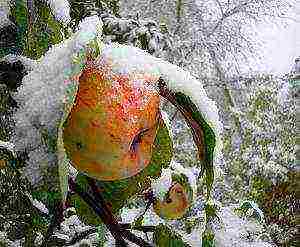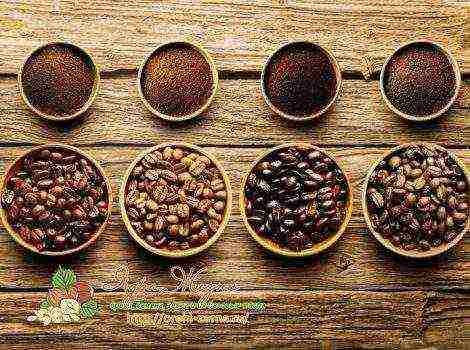Content

Not so long ago, long-fruited (or simply long) cucumbers came into service with our gardeners. This variety quickly gained favor, since the yield of 1 such bush exceeds the performance of several shoots of species that have long been familiar to us. Large sweet fruits are well stored, retain their taste, the fruiting period of plants is long enough, and caring for them is not difficult. Of course, long cucumbers also have their drawbacks and before planting, you should weigh all the pros and cons several times. In this article, we will consider all the nuances of growing this variety.
Characteristics and description of the variety
Long-fruited cucumbers include several species at once, which have similar characteristics, origin and cultivation specifics. All of them have massive branchy shoots and form lush bushes, replacing 3-4 bushes of common varieties. There are few stepsons on them, so there are no problems with pinching. A lot of dark green fleshy foliage and strong whiskers grow on the lianas, so the plant “grabs” the support on its own, almost without outside help. The root system of long cucumbers, like that of their counterparts, is pivotal, poorly developed.
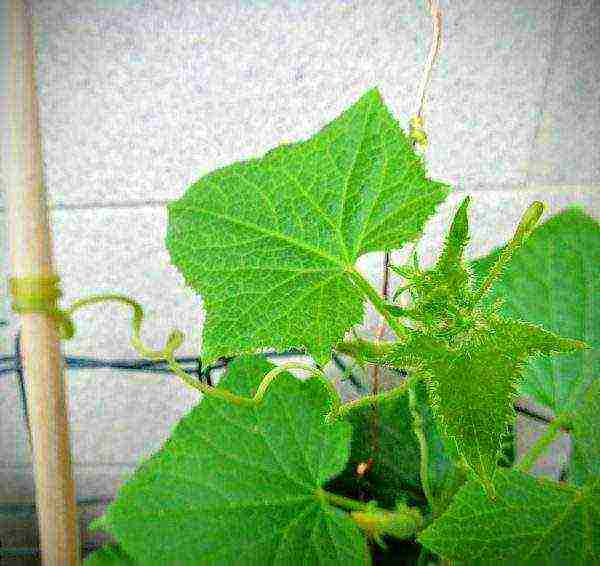 Long-fruited cucumbers develop strong whiskers so they do not require tying
Long-fruited cucumbers develop strong whiskers so they do not require tying
Most of these varieties are early maturing, even in the latest ones, the ripening period does not exceed 55-60 days from the moment of germination.... A full-fledged fruit from the ovary forms quickly, throughout the entire growth, cucumbers retain their sweetness and never taste bitter, the skin does not coarse, remains soft and juicy. The shape and length of zelents are the main feature of the variety. Vegetables grow in an oblong shape, most often of dark green color (although there are also white-yellow subspecies among them), and the length varies from 25 to 60 centimeters. The peel is thin, the surface has either longitudinal depressions or small frequent tubercles.
Self-pollination is not characteristic of long-fruited cucumbers; external factors are involved in this process (in natural conditions, these are insects). Therefore, during the flowering period, it is recommended to carry out pollination by hand until the first ovaries are formed.
Features of the variety
Long cucumbers have a number of characteristics, which are largely due to the region of their origin. Among these characteristics, there are several factors that need to be paid attention to. First of all, you should understand the shortcomings of long varieties so that it does not become an unpleasant surprise after.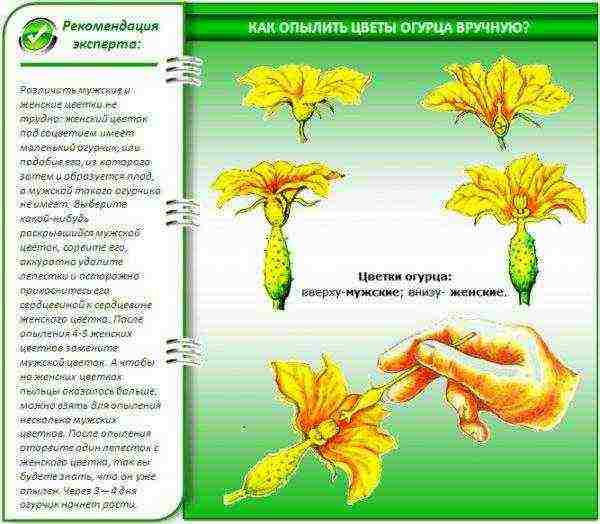
Country of withdrawal
The historical homeland of all long-fruited varieties of cucumbers is East Asia, or rather southeastern China. In this region, the climate is most comfortable for the ripening of large vegetables. Later, when demand for this product increased, Chinese breeders bred about 10 varieties of them, suitable for different natural conditions. For this reason, long cucumbers are often called Chinese, although this is not entirely true - some of them (for example, zozulya) were bred by our scientists on the basis of foreign varieties.
 Cucumbers variety "Zozulya"
Cucumbers variety "Zozulya"
To prevent cucumbers from taking root easier, choose the right varieties.For the temperate strip, Zozulya or the Chinese cold-resistant hybrid F1 (has good reviews) is best suited, and for the southern regions of Russia, the Chinese heat-resistant F1.
Advantages and disadvantages
Undoubtedly, long cucumbers have a number of significant advantages, otherwise they would not have been able to gain such popularity among farmers. Their first advantage is their high yield, regardless of weather conditions and the length of daylight hours. Their second quality is considered to be unpretentious in care and resistance to many diseases.... When planted correctly, cucumbers won't give you much of a problem. Long varieties actively branch, but do not give infertile stepchildren. Another important fact is the ability to adapt to the climatic conditions of any region.
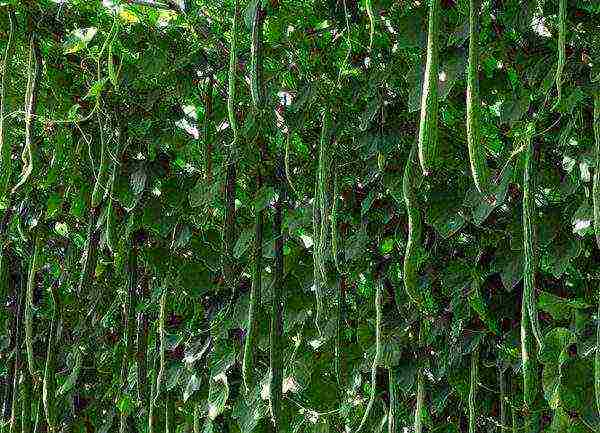 The advantage of long-fruited cucumbers is their high yield.
The advantage of long-fruited cucumbers is their high yield.
Before you breed cucumbers of this kind in your garden, you need to know about their shortcomings. Remember the poor germination of seeds, out of 10 only 3-4 can hatch. Long-fruited species need a lot of space - the bushes branch strongly and interfere with neighboring plants, as a result of which their growth is inhibited. Think in advance for what purposes you are going to grow cucumbers, because pickling such long Zelentsy is difficult, and transporting whole is even more difficult (the thickness of the fruit does not exceed 4-6 cm, which makes them extremely fragile).
 Long-fruited cucumber varieties have poor seed germination
Long-fruited cucumber varieties have poor seed germination
Leave the seeds in warm water for a few days before planting until the young shoots break through. Plant 2 seeds per hole in the soil or cups. Thus, you will ensure germination, and excess plants can be thinned out.
Growing
The cultivation of long-fruited cucumbers is not much different from the varieties we are used to. This is a melon culture and it needs high beds, the basis of which is a "pillow" of manure and humus. It is better to start laying the beds in the fall, so that organic matter begins to decompose and "burn" by the time the seedlings or seeds are planted. During the active growing season, it is necessary to ensure regular watering, the soil should be moist and loose. Systematic application of dressings (both organic and mineral) will prolong the fruiting period and improve the palatability of the fruit. However, for crops grown in a greenhouse and open field, there are subtleties.
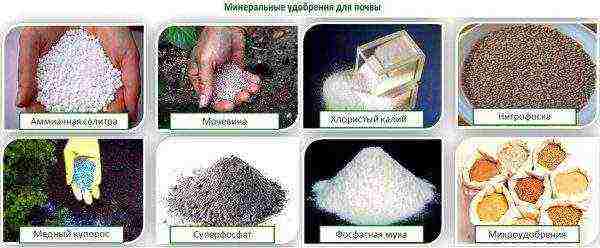 To obtain a large volume of yield, add mineral and organic fertilizers to the soil.
To obtain a large volume of yield, add mineral and organic fertilizers to the soil.
The main thing for long cucumbers in the open field is the soil rich in organic fertilizers. The watering regime depends on the weather, but it is recommended to carry it out twice a day, in the morning and in the evening. Top dressing is carried out three times per season. In order for long-fruited cucumbers to bring the maximum yield, it is necessary:
- planting plants in well-heated soil;
- equip a frame for a vertical garter (the fruits should never touch the ground);
- when choosing top dressing, give preference to organic fertilizers;
- regular weeding;
- ensuring a constant temperature for young shoots (cover the seedlings with foil overnight).
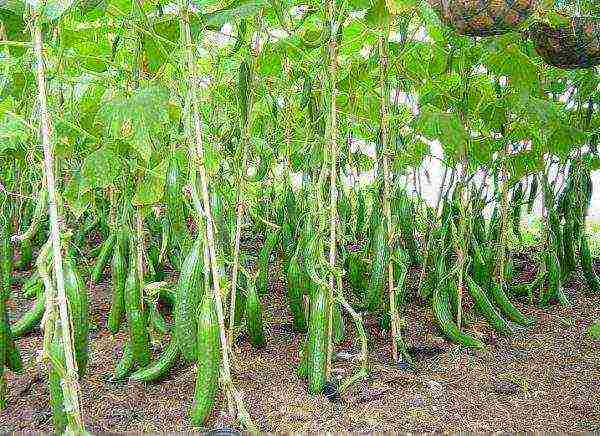 Garter cucumbers using the "Blinding" method
Garter cucumbers using the "Blinding" method
As a top dressing, use an infusion of manure or chicken droppings, mixed in a 1: 1 ratio with herbal decoction. Before watering, dilute the infusion with water and pour 1.5 liters per bush.
In the greenhouse
A greenhouse is a better option for growing long-fruited cucumbers, since a constant temperature and humidity can be ensured here. It is also much easier to set the correct vertical direction for the lianas in such conditions, and organic fertilizers laid down in the fall will be enough for most of the season (but minerals will have to be added additionally). It is also recommended:
- water once a day in the evening;
- open the windows and doors of the greenhouse in the morning to ventilate the room (don't forget to close at night);
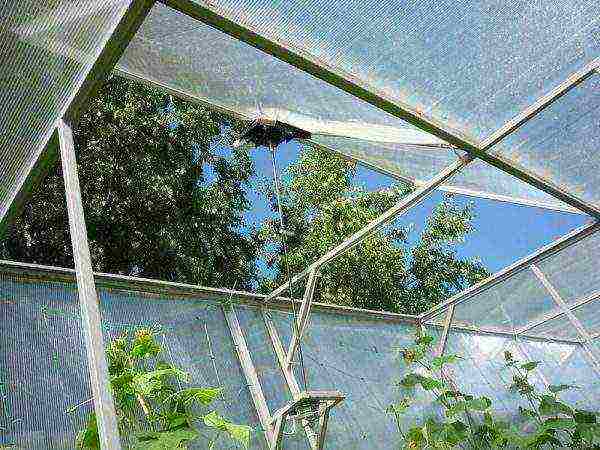 When irrigated in the evening, the greenhouse is ventilated
When irrigated in the evening, the greenhouse is ventilated
- apply mineral fertilizers (potash nitrate, wood ash, urea);
- remove yellowed and withered shoots so that rotting does not spread and excess moisture does not linger;
- constantly loosen the soil.
Don't plant long cucumbers too often. Place the holes 50-60 cm apart so that the bushes do not intertwine and do not interfere with each other's growth.
Yield
As already mentioned, the yield of long cucumbers is their main advantage. Up to 10-15 kg of vegetables can be harvested from one bush per season. For maximum yield, correct growth and development of the shoots must be ensured. As soon as 5-6 true leaves are formed, it is necessary to "blind" the vine, that is, remove the top along with the top leaves and mustache. This will allow the bush to grow more ovaries and will also reduce the number of non-fruiting shoots.
 Cucumber variety "Zozulya" can give up to 20 kg of fruit per square meter
Cucumber variety "Zozulya" can give up to 20 kg of fruit per square meter
Long-fruited cucumbers are not capable of self-pollination, therefore, manual pollination will have to be carried out to ensure yield. Use a cotton sponge or a soft cloth to transfer pollen from flower to flower (keep in mind that female flowers grow more often on the main vine, and male flowers on the side ones).
Diseases and pests
The big plus of long cucumbers is their resistance to the most common diseases - powdery mildew and downy mildew. But their large fragile fruits are often exposed to olive brown spot - this is a fungus that infects cucumbers even in the ovary, both in the greenhouse and in the open field. It is also worth monitoring the condition of the soil; in too wet and dense soil, the plants are affected by root rot. Remember that strong healthy plants are better resistant to diseases, that is, proper care (weeding, feeding, proper watering and drainage) will protect you from these scourges.
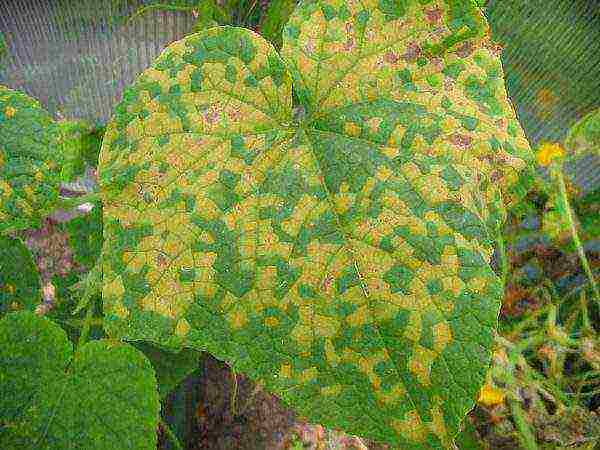 Peronosporosis was previously considered an incurable disease of greenhouse cucumbers.
Peronosporosis was previously considered an incurable disease of greenhouse cucumbers.
The most common pest of cucumbers in our country is aphid. Along with the spider mite, this insect infects the leaves of the plant, which slows down its growth and fruit formation. Also, long cucumbers suffer from whitefly, the larvae of which damage the lower parts of the shoots. To prevent damage from pests, constantly monitor the condition of the plants (paying attention to the back of the leaf plate).
Wood ash is a wonderful remedy for diseases and pests - sprinkle it on the shoots in the evening after watering. You can also spray the plants with a decoction of nettles or onion peels. And watering with such tinctures will strengthen and protect the roots.
Video
conclusions
Long-fruited cucumbers are a godsend for farmers who want to get a high yield. Like other varieties, this species has a number of disadvantages that must be taken into account when choosing. Also, do not plant them for those who plan to pickle cucumbers. Long varieties are only suitable for fresh consumption. Growing is not much different from the process familiar to gardeners, but it has some nuances that will improve yield indicators.
Have you heard of such a wonderful vegetable as Chinese cucumber? Let's take a closer look at its best varieties, which gardeners have already appreciated.
Chinese cucumber is a kind of common cucumber that we are familiar with. True, the fruits of this culture grow elongated and thin, reaching a length of 30 to 80 cm. And this is not all the features of the Chinese cucumber. It tastes sweeter and more aromatic (the pulp exudes the smell of watermelon or melon), and its skin is never bitter.
Chinese cucumbers are grown both in the greenhouse and in the open field. They ripen well even in the unstable weather of the middle zone, since many varieties are early ripening (only 25-35 days pass from emergence to fruit formation). So, with proper care from one bush, you can collect up to 30 kg of tasty and unusual fruits.In addition, Chinese cucumbers are resistant to many cucumber diseases and are able to bear fruit until frost, even in the shade.
However, this "foreign" culture has several drawbacks: the fruits are not stored for long, therefore they are best suited for salads, the seeds often do not germinate well, and when growing, you have to tinker with the correct vertical garter, otherwise the cucumbers will grow ugly, hooked.
So, if you decide to try to grow such an unusual cucumber on your site, take a look at these varieties, which are designed for both the greenhouse and unprotected soil.
1. Alligator F1
This is an early non-self-pollinating hybrid. On the strong bushes of these cucumbers, which grow very quickly, lumpy, rich green, cylindrical fruits ripen until mid-October. They have excellent taste: very thin peel without bitterness, as well as juicy, sweet and aromatic flesh.
The name of this hybrid has become a household name, and now gardeners often call any long Chinese cucumbers alligators.
Alligator F1 Chinese cucumber is most often grown through seedlings. Seeds are sown in the first half of April, then in the phase of 2-3 leaves, the seedlings dive into separate containers, and at the age of 30 days (usually in the second half of May) they are transplanted into a greenhouse or open ground.
Alligator F1 cucumbers are resistant to most diseases, but sometimes the bushes can be infected with downy mildew.
| Appointment |
Maturation (number of days after germination) |
Fruit length (cm) |
Fruit weight (G) |
Yield (kg from 1 sq.m.) |
|
| 46-48 |
35-40 |
280-300 |
16-18 |
||
2. White delicacy
This variety got its name for its unusual skin color for a cucumber: it is almost white, sometimes with a slight greenish tinge. Compared to other Chinese cucumbers, the fruits of the White delicacy are not very long (up to 15 cm), conical in shape. Their peel and pulp are very tender, tasty and juicy.
Seeds are sown for seedlings in March, and at the age of 30 days they are transplanted into a greenhouse or into the ground under a film shelter. Cucumbers of this variety easily tolerate worsening weather, are insensitive to sudden temperature fluctuations and changes in air humidity.
| Appointment |
Maturation (number of days after germination) |
Fruit length (cm) |
Fruit weight (G) |
Yield (kg from 1 sq.m.) |
|
| 45-50 |
12-15 |
90-120 | |||
3. Emerald Stream F1
This is a parthenocarpic hybrid of Russian selection. Bushes grow tall, but weave poorly. Fruits are cylindrical, dark green in color. They have a thin peel covered with numerous tubercles, the flesh is very fragrant.
Seeds are sown for seedlings in mid-April, and planted in the ground when the threat of return frosts has passed (in a heated greenhouse - earlier).
The bushes of this hybrid do not suffer from powdery mildew, are insensitive to lack of light and temperature changes, and are not afraid of frost.
| Appointment |
Maturation (number of days after germination) |
Fruit length (cm) |
Fruit weight (G) |
Yield (kg from 1 sq.m.) |
|
| 44-48 |
Up to 50 |
Up to 200 |
6-8 |
||
4. Chinese snakes
These arched cucumbers are most often grown in heated greenhouses: this allows you to plant seedlings in protected ground in early May and by the end of the month to collect a good harvest of long fruits. Bushes - very powerful, branched, long-term yield. Fruits are dark green, with large, but few tubercles.
| Appointment |
Maturation (number of days after germination) |
Fruit length (cm) |
Fruit weight (G) |
Yield (kg from 1 sq.m.) |
|
| 35-37 |
50-60 |
150-200 |
10-15 |
||
5. Chinese heat resistant F1
As you might guess from the name, this hybrid is resistant to high temperatures (up to 35 ° C). The bush branches well, forms few stepsons and, as a rule, forms one main stem. The fruits are long, even, shaped like a cylinder. Their thin skin is covered with large tubercles. The pulp is sweet and aromatic.
This Chinese cucumber is resistant to powdery mildew, downy mildew and fusarium wilt.
With the seedling method of growing, the seeds are sown in special containers throughout April, but you can sow directly into the ground - in the second half of May. In this case, the soil must warm up to 20-25 ° C, otherwise the seeds will not germinate. Therefore, in regions with a cool climate, it will not be possible to do without a film shelter.
| Appointment |
Maturation (number of days after germination) |
Fruit length (cm) |
Fruit weight (G) |
Yield (kg from 1 sq.m.) |
|
| 48-54 |
30-50 |
Up to 300 |
To 10 |
||
6. Chinese cold-resistant F1
This hybrid is suitable for growing outdoors (on trellises), greenhouses and winter greenhouses. The bushes grow very quickly, the fruits ripen long, dark green, cylindrical in shape. The thin peel is covered with numerous tubercles. The pulp is aromatic and very sweet.
This Chinese cucumber is resistant to cold, not afraid of frost, grows well in the shade, resists powdery mildew and fusarium.
| Appointment |
Maturation (number of days after germination) |
Fruit length (cm) |
Fruit weight (G) |
Yield (kg from 1 sq.m.) |
|
| 50-55 |
30-50 |
Up to 300 |
To 10 |
||
7. Chinese miracle
This unpretentious plant bears fruit well in both heat and cold. But for proper development, the borage needs light and regular watering. Long, dark green, slightly curved fruits are very tasty, their thin rind is usually smooth, only occasionally a few tubercles appear on it. The bushes are powerful, but not spreading, bear fruit abundantly until late autumn and have good immunity to major crop diseases.
| Appointment |
Maturation (number of days after germination) |
Fruit length (cm) |
Fruit weight (G) |
Yield (kg from 1 sq.m.) |
|
| 60-70 |
35-45 |
300-500 |
10-15 |
||
If you liked this bizarre culture, you will find even more funny cucumbers in our article Unusual and exotic types of cucumbers for a summer residence.
Long cucumbers differ from other varieties in their appearance. They taste good and are more watery. These varieties usually yield good yields. Depending on the type chosen, the length of the cucumber can reach 50 cm, and the weight is 220 g.
Varieties
By type, cucumbers are conventionally divided into hybrid and varietal. Varietals make it possible to use their seeds for a new planting.

Long cucumbers are easy to grow in your own garden
The most unpretentious varietal species are:
- "Chinese miracle" - the length of the cucumber reaches 45 cm.
- "Phoenix 640" - the length of the fruit is 18 cm.
- "Pallas' cat" reaches 22 cm in length.
Photos of long cucumbers and methods of growing a particular species can be seen on the package with seeds.
Fruiting is observed 2 months after planting. These varieties are bee-pollinated, therefore, when grown in a greenhouse, they will need to be artificially pollinated.
These long-fruited cucumbers can be eaten fresh and are also ideal for pickling and preserving.
Hybrid varieties
Among the hybrid varieties, it is better to give preference to the following:
- "Zozulya". The length of the cucumber is 18 cm, and the weight reaches 200 grams.
- "Regal" - a mature fruit grows up to 18 cm and weighs 120 g.
- "April" - cucumbers 25 cm long, weighing 120 grams.
- "Chinese heat-resistant" cucumber reaches 50 cm.
- Stella will delight you with 25 cm cucumbers.
- "Mustafa" will bear 20 cm of fruit, weighing 200 grams.
Hybrid cucumber varieties do not require pollination. Most often, hybrids do not have seeds, so they can only be grown once.
The first fruits appear after 45 - 50 days, and "Stella" will delight with the harvest a little later - about 65 days after planting. It is best to grow them in a greenhouse or greenhouse.
Cucumbers can be eaten fresh and canned for the winter. Chinese Heat Resistant Hybrid is best eaten fresh or added to salad.
Chinese varieties of cucumbers, for example, "Lifent Senius" or "Sintyai" can be grown outdoors, but they will be more comfortable in a greenhouse.
Hybrids of Chinese cucumbers, for example, "Chinese Miracle" or "White Delicacy", are unpretentious in cultivation, are resistant to diseases and are not afraid of frost. Their length can be up to 80 cm, but for this they should be tied up in time.
Overripe fruit will not turn yellow on the skin, but the seeds will be large. Cucumbers should not lie on the ground, as they will lose their shape and may deteriorate.
Long-fruited cucumbers are delicious and healthy vegetables on the table at any time of the year.
See also: description of Verliok's tomatoes
The success of the cucumber crop depends in particular on the choice of seed. The wide assortment on the shelves confuses thoughts rather than allows you to make the right decision. Novice gardeners are advised to first familiarize themselves with the varieties, their names, the characteristics of cultivation and care.
Depending on climatic conditions, different varieties can be planted in Ukraine, Belarus, Chernozem, Bashkiria and the middle lane - these can be parthenocarpic, early ripening, with a long ripening period, or delicious cucumbers for growing in a greenhouse. More information is structured in the article in the form of a kind of list-rating.
Varietal variety of cucumbers
A large number of varieties allows you to choose the best options that have disease and weather resistance the region where the green plant is planned to be grown.
A common mistake is the use of certain 2-3 varieties, the cultivation of which has been practiced for several decades.
Domestic and foreign breeders have developed many hybrids that have no less affordable agricultural technology and excellent taste than the once loved cucumbers.
Experts among the top tips for growing vegetables point to the need to plant several varieties at once... This makes it possible to evaluate the yield of different species under the same ripening conditions, to get at least some yield during drought or prolonged rains.
Collect the necessary and useful information about the varietal variety, the characteristics of the characteristics of zelents can be found below.
The most popular varieties with names
For the convenience of perception and application of the text in practice, plants are divided into separate groups, united by a common feature.
The best self-pollinating for outdoor use
Self-pollinating cucumbers have a number of advantages, among which excellent immunity and resistance to an abundance of moisture are noted.
- Booth - ripening period is only 40 days. The length of the green plant reaches 9 cm. One bush yields up to 3.5 kg. The strong immunity of the plant resists various diseases (olive spot, mosaic, powdery mildew).
- Courage - harvesting of the Kurazh variety begins 40-47 days after the sprouts break through from the soil. The weight of one cucumber reaches 170-180 gr., Up to 10 zelents are formed on one shoot. The plant practically does not suffer from rot, powdery mildew.
- Connie - harvesting of fruits begins on the 50th day after sowing. The culture is universal both in the way of cultivation and in the use of cucumbers. The length of the greenery is 10 cm, the yield from 1 m2 is about 9 kg.
- Berendey - fruits (12-15 cm) ripen 42 days after the emergence of sprouts. You can harvest up to 3.5 kg from one bush. Zelentsy have excellent characteristics and have a long shelf life.
- Gerda - fruits 10 cm long appear 1.5 months after sowing. 2.8-3 kg are removed from the bush. The plant is rarely affected by diseases; it is especially resistant to fungal infections.
The best early ripe cucumbers
Early ripening varieties have a feature that every gardener should be familiar with.
The ovaries of male flowers are the first to form, they must be removed, since they interfere with the development of the plant.
- April - from the moment of planting, the fruits of April ripen on the 50th day, reaching a length of 20-22 cm. The plant itself regulates the growth of shoots, so the need for pruning disappears. Productivity from 1 m2 on average 22 kg. Cucumbers do not overripe if they miss the assembly deadline. The culture is resistant to almost all diseases, with the exception of root rot.
- Hermann - sprouts at 39-41 days after sprouting.The length of Herman's greens reaches 10 cm, 23-26 kg are harvested from 1 m2. The hybrid is characterized by a long fruiting period, self-pollination and immunity to fungi.
- Orlik - begins to bear fruit on the 47-50 day after sowing. The length of the greenery reaches 14-16 cm, with a diameter of 3.5-4 cm. 6-8 kg are removed from the bush. The culture has a strong immune system, resists powdery mildew, root rot, olive spot and TMV.
- Valdai - the bush begins to bear fruit on the 45th day after the emergence of shoots. Flowers are formed predominantly by women, therefore pollination by bees is required. The length of the greenery is about 10-11 cm, up to 4.5 kg of the crop are removed from the bush. The hybrid was developed for preservation, but due to its delicate taste it is also used for salad.
Mid-season
Medium ripening varieties begin to bear fruit on the 45-55 day after sowing the seeds into the soil. All plants of this group differ in the method of cultivation (greenhouse, soil), purpose (fresh or for salting) and the type of pollination.
- Competitor - characterized as a plant that loves life and is resistant to diseases. The length of the greenery reaches 9-12 cm with an average weight of 100 grams. Up to 3.8 kg of the crop is harvested from each m2. The variety has good immunity and is resistant to powdery mildew.
- Nezhinsky - a variety pollinated by bees, characterized by a powerful stem, medium-sized fruits (length 10-12 cm, weight 90 g) and high yield (8 kg per 1 m2). Nezhinsky tolerates low temperatures and is resistant to many diseases. Cucumbers have a high taste.
- Libella - a versatile hybrid with a long fruiting period. With proper care, you can harvest until the coldest days. The length of the Libelle greenery reaches 14 cm, weight - 140 grams. Up to 10-12 kg are removed from a square meter. When salted, the flesh remains crispy and firm. In agricultural technology, there are rarely cases of damage to crops by common diseases.
- Table - has an excellent taste without bitterness, ideal for salting. The bush is formed long with a strong lash, the length of the fruit reaches 12 cm with a weight of 80-90 grams. Productivity from 1 m2 about 8 kg.
Late ripening
A feature of late-ripening cucumbers is that the seeds germinate well only in the 3rd year.
Therefore, the purchased material before planting is worth check for germination... Also, when choosing varieties of this group, you need to take into account the climate of the region and the ripening period of zelents in order to have time to collect most of the harvest before the onset of cold weather.
- Phoenix - the harvest period begins 64 days after seed germination. Cucumbers reach a length of 16 cm, with an average weight of 230 g. Phoenix bushes form a branched whip that resists the vagaries of the weather well.
- Winner - differs in long spreading lashes that easily tolerate drought, coolness. The plant is resistant to various types of fungi. Fruit length reaches 14 cm with an average weight of 110 grams. The yield from 1 m2 is 7-8 kg.
- Solar - the variety is mid-season, but most gardeners plant it as late. The bush releases many twigs, forming a massive whip, which implies planting in a large area. The peel of the greenery is covered with a few tubercles and greenish stripes. The length of a cucumber reaches 12 cm with an average weight of 140 grams.
- Brownie - the harvest period begins 65 days after germination. The length of the cucumbers is small (9 cm), but the taste is high. The culture has good immunity, showing resistance to almost all common diseases. Productivity - 6-8 kg per 1 m2.
- Chinese - a disease-resistant variety with a mild taste and lack of bitterness. A feature of the fruit of the Chinese cucumber is considered to be a short shelf life after harvest. Original elongated cucumbers (30-35 cm) look like snakes. The plant tolerates low temperatures and poor lighting well.
Which are the highest yielding for greenhouses
All gardeners, without exception, are attracted by high-yielding varieties. In your greenhouse, you can try to grow the most popular of them.
- Parisian gherkin - fruits ripen in 50-60 days after sowing. The length of the Parisian gherkin variety reaches 12 cm with an average weight of 85 grams. A large number of ovaries are formed on the lash, which guarantees a high yield - over 30 kg per 1 m2. Low germination of seeds provides for planting beds through seedlings.
- Fontanelle - a popular cucumber among gardeners in our country. It is grown in almost every area. The dimensions of the Spring greens reach 22-24 cm with an average weight of 150 grams. More than 10 kg are removed from the bush. In terms of taste and rules of agricultural technology, the variety remains competitive before the best European developments of breeders.
- Zozulya - the harvesting period begins on the 45th day after the emergence of the shoots. The formation of the lash is carried out in such a way that the bush does not need pruning. Zelentsy reaches 24 cm in length with an average weight of 280-300 grams. From a square meter, you can collect up to 30 kg of Zozulya cucumber. The plant practically does not get sick with olive spot and cucumber mosaic.
For planting outdoors
- Suzanne - a versatile crop that can be grown not only in the open field, but in a greenhouse and even on a balcony. The length of the lash reaches 3-4 m, forming a large number of ovaries. Plucking fruits 3-4 centimeters long or wait until they become larger, this does not affect the taste. Suzanne has good disease and pest resistance.
- Sparta - the hybrid is bee-pollinated with stable fruiting. The length of the greenery is 6-12 cm, the taste is pleasant without bitterness. The culture has a strong immunity, especially against powdery mildew and fungi. The yield per bush is 2.8-3.1 kg.
- Pickle - the fruiting period begins on the 55th day after the emergence of sprouts. The length of the green leaf is 9-11 cm with an average weight of 100-110 grams. More than 4 kg are removed from one bush. The pickle has a delicate taste with a sweetish note, without bitterness.
- Pinocchio Is a self-pollinated hybrid that begins to ripen 48 days after germination. The length of the greenery is about 8-9 cm with a weight of 85 grams. The yield per bush is 3.4 kg.
- Sturdy - by the rate of ripening, the cucumber is considered a sprinter, just 38 days after the emergence of sprouts. The length of the greenery is about 9 cm with a weight of 80 g. The fruiting period is fleeting, all ovaries form and ripen together. Unfavorable weather does not have a negative effect on the growing season.
For growing in Siberia
Growing cucumbers in a harsh climate has its own characteristics. It is better to plant cucumbers in Siberia in polycarbonate greenhouses or choose fruitful early maturing varieties.
When choosing seeds, preference should be given to varieties that are resistant to stress.
- Altaic - it has a short ripening period, the harvest begins 36-40 days after germination. The length of the greenery is 9-12 cm with a weight of 100 g. The plant is cold-resistant, easily tolerates the vagaries of the weather. After harvesting, fruits retain their presentation and taste for a long time.
- Serpentine - gherkin type cucumber, ripens 39-42 days after germination. The fruiting period is intense, already in the first 10 days most of the harvest is harvested - over 1.7 kg per 1 m2. Serpentine is known for its taste, which lacks bitterness.
- Bush - a compact plant that needs pollination. The length of the greenery reaches 8 cm with a weight of 90 grams. Productivity is stable with proper care (3 kg per bush). The peculiarity of the variety is its endurance and strong immunity. Cucumbers are versatile.
Each variety of cucumbers has an impressive set of benefits. The main thing when choosing is to take into account the climatic features of the region and the correspondence to them of the characteristics of the varieties you like. Then the main stage of laying the future harvest will be performed correctly.

